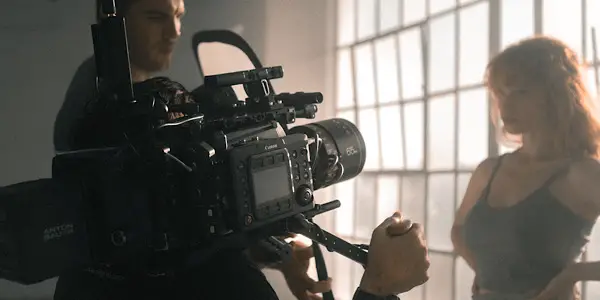A Quick Guide To Movie-Making: What You Need To Know

Kristy Strouse is the Owner/Editor in Chief of Film Inquiry,…
Studying film theory is a great way to take a deep dive into the world of moviemaking, but producing a great movie requires finesse. Staying organized is key to making a movie like the pros do. Let’s explore all of the preproduction planning, casting, and editing steps you have to take to ensure the production of your movie goes smoothly.
Your Preproduction Checklist
In general, there are 10 things moviemakers must do during preproduction. You might rearrange the order of these items, but this structure is generally the most sensible.
- Lock the shooting script. This doesn’t have to be done first, but it’s the ideal place to start. Use a shot list template to organize.
- Finalize your budget. Be realistic about how much you have to spend, and where each dollar is going.
- Form a business entity. This entity will handle the contracts, insurance, release forms, and other legalities of movie-making.
- Hire your production crew. Every movie starts with a producer (you) and a script, but you need to add essential crew members. The first one will include a line producer or production coordinator.
- Break down the script. Take the words you’ve written, format them, and add notes about props, scenes, locations, and costumes.
- Create a storyboard. This takes your verbal script and makes it visual.
- Scout your locations. Determine where the scenes will take place.
- Give the art department time to prep. The more complex the sets, the more time they need.
- Consult a legal professional about any permits and insurance you might need.
- Come up with a shooting schedule.
Once you’ve got these things checked off, the next step is to move forward with casting.
Casting for Your Movie
You may have already started casting for your movie, but now is the time to move forward with all the roles. Casting requires you to:
- List out all the roles you require, including extras.
- Think about who’s the best fit to fill each role.
- Create your casting calls detailing who you need.
- Audition potential talent and make your decisions.
In general, you’ll have talent come back for a follow-up audition after they’ve made the shortlist. That means, if 10 people audition for the lead role, you might shortlist 2–3 of them and have them come back before you make your final decision. The second audition tends to be a bit more involved and might require hair, makeup, and/or costume so you can really see who will best fill the role.

If you’re new to running auditions, it might be helpful to have a couple of people along who understand your vision and the script very well. These individuals can help you visualize who may be the best fit for the role and help you say a polite “no” to those who aren’t.
Achieving Seamless Editing
Filming the movie is, by far, the most exciting part. The filming period is when you see your ideas come to life, acted out right in front of you. However, it’s the editing process that’s really going to make or break your movie.
When you edit your movie, you are splicing together multiple angles and clips while also adjusting lighting and sound elements. When done right, the editing process will produce a coherent, meaningful story. When done wrong, editing can leave jarring transitions and sound imbalances that wreck your hard work. Fortunately, a poorly edited film can always be re-edited, just make sure you save those raw materials.
With all of that in mind, editing isn’t strictly a post-production activity. To make a great movie, you must be in the editing mindset at all times. Here are some other tips:
- Consider continuity and coverage while filming your movie.
- Only use the clips that matter, but don’t delete something unless it’s entirely unusable.
- Choose clips that focus on the most important element of the scene.
- Every time you edit, show something new, like a new view or subject.
- Don’t put two similar clips together. Always vary the shot size and angle of the shot.
- Use mid-shots (in-between sizes) to transition between close-ups and long shots.
- Pace your shots correctly. Too fast and people miss the action. Too slow and it drags out.
- Choose your transitions carefully. These “join” two shots.
- Pay close attention to your sound. It should match your edits and carry the film forward.
- Don’t get lost in a single shot. Always remember the big picture of your movie!
If you follow the above process for movie making when filming and editing, you can successfully create your own films. With a good understanding of what makes a good narrative, and a basic knowledge of the tools and techniques above, you can make for a professional-level movie that people will be excited to watch and you’ll be proud to showcase—without needing to enlist the help of a professional.
Does content like this matter to you?
Become a Member and support film journalism. Unlock access to all of Film Inquiry`s great articles. Join a community of like-minded readers who are passionate about cinema - get access to our private members Network, give back to independent filmmakers, and more.
Kristy Strouse is the Owner/Editor in Chief of Film Inquiry, writer, podcaster, and all around film and TV fanatic. She's also VP of Genomic Operations at Katch Data and is a member of The Online Association of Female Film Critics and The Hollywood Creative Alliance. She also has a horror website: Wonderfully Weird & Horrifying.













